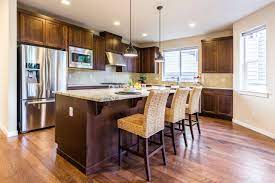Introduction
Kitchen cabinets play a vital role in the aesthetic appeal and functionality of a kitchen. Over time, however, they may start to show signs of wear and tear, leaving your kitchen looking outdated and tired. Fortunately, there’s a cost-effective solution to breathe new life into your old cabinets: refinishing. In this article, we’ll explore some tips for reviving your old kitchen cabinets through refinishing.
Assessment of Current Cabinets
Before diving into the refinishing process, take some time to assess the current condition of your cabinets. Determine if they are structurally sound and if refinishing is a feasible option based on their age and material.
Gathering Supplies
To refinish your kitchen cabinets, you’ll need a few essential supplies. These may include sandpaper, wood filler, primer, paint or stain, brushes or rollers, and new hardware if desired. Take the time to choose the right paint or stain color to achieve the look you want for your kitchen.
Preparation
Start by thoroughly cleaning and degreasing the cabinets to remove any dirt, grime, or residue. Next, remove the cabinet doors and hardware to make the refinishing process easier.
Repairing and Sanding
Inspect the cabinets for any cracks, holes, or scratches, and fill them in with wood filler. Once the filler has dried, sand the surfaces of the cabinets to create a smooth base for painting or staining.
Priming
Applying a coat of primer is essential before painting or staining your cabinets. Primer helps the paint or stain adhere better to the surface and ensures a more durable finish. Choose a primer that is suitable for the type of cabinets you have.
Painting or Staining
Once the primer has dried, it’s time to apply the paint or stain. Use a brush or roller to apply thin, even coats, working in the direction of the wood grain. Be patient and allow each coat to dry completely before applying the next one for a professional-looking finish.
Adding Finishing Touches
After the paint or stain has dried, consider replacing the hardware with updated knobs or handles to complete the new look of your cabinets. You may also need to install new hinges if the old ones are worn or damaged.
Reassembling Cabinets
Once all the finishing touches are in place, reattach the cabinet doors and hardware, making any final adjustments as needed to ensure everything is aligned properly.
Maintenance and Care
To keep your newly refinished cabinets looking their best, practice regular maintenance and care. Clean them regularly with a mild soap and water solution, and avoid using abrasive cleaners that could damage the finish.
Benefits of Refinishing
Refinishing your kitchen cabinets offers several benefits. Not only is it more cost-effective than replacing them entirely, but it’s also a more environmentally friendly option since it allows you to repurpose existing materials and reduce waste.
Conclusion
Reviving your old kitchen cabinets through refinishing is a budget-friendly and sustainable way to update the look of your kitchen. By following these tips and taking the time to properly prepare and execute the refinishing process, you can transform your old cabinets into a fresh and stylish focal point of your kitchen.
